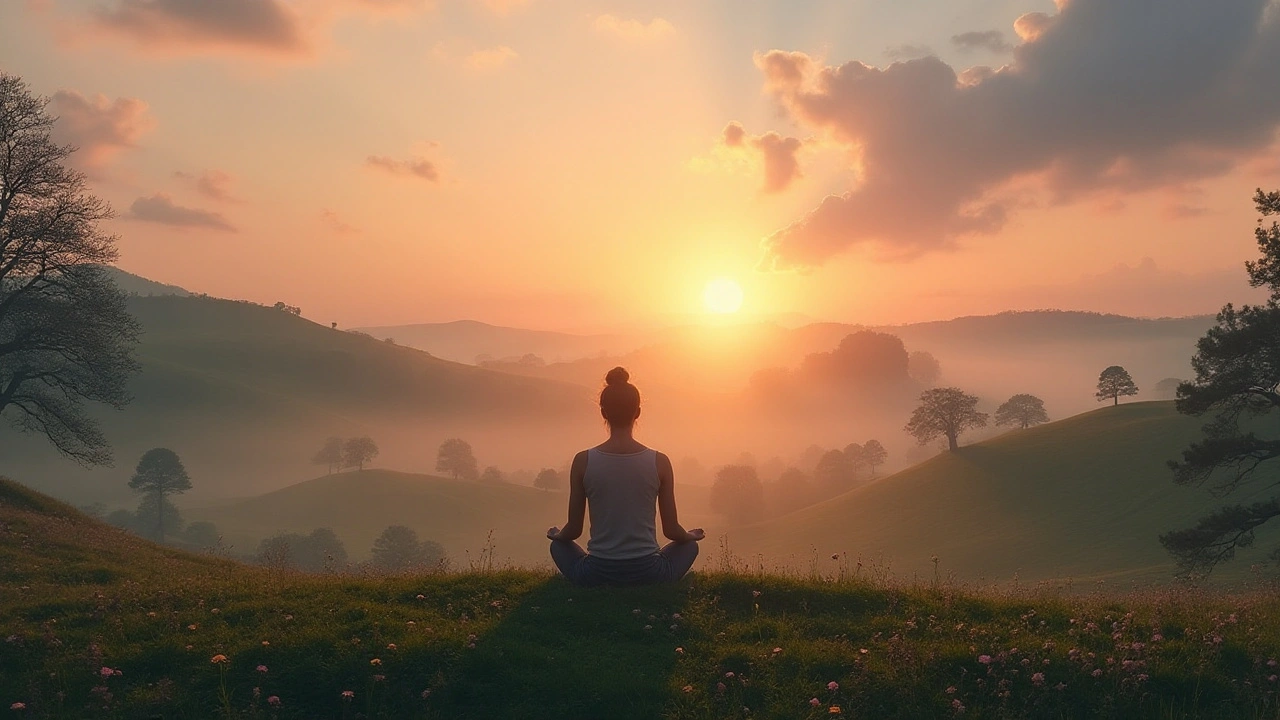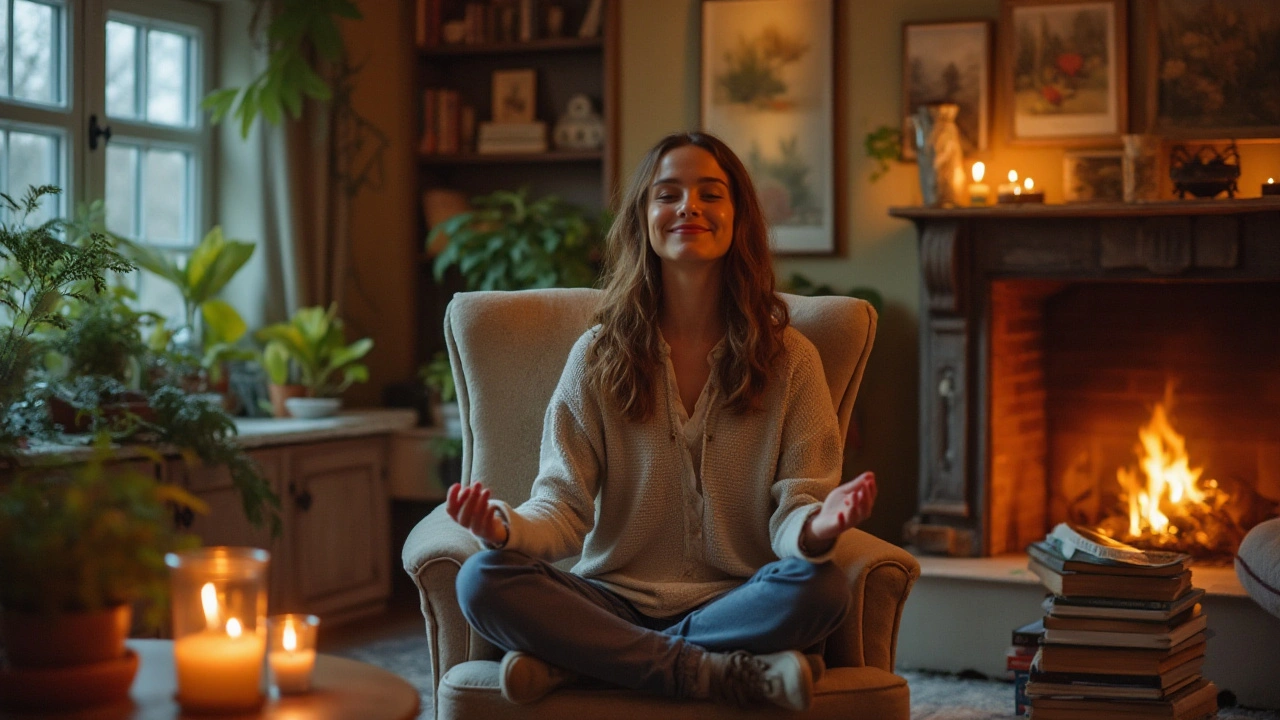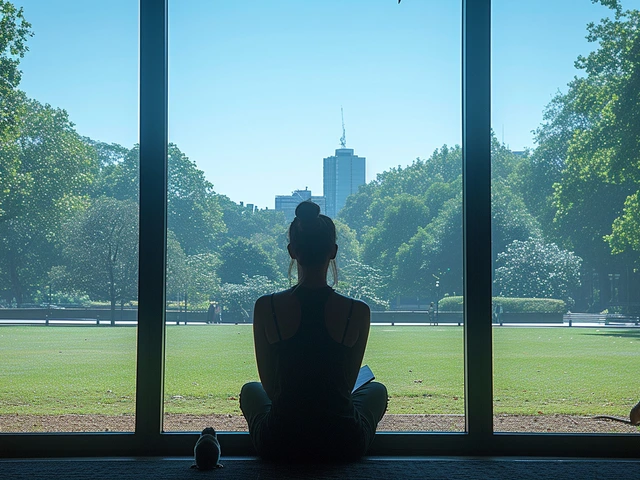
Meditation is a timeless practice embraced by people from all walks of life. In today's world, many are seeking ways to reduce stress and find clarity, making meditation more relevant than ever. Surprisingly simple, yet incredibly powerful, these techniques offer a way to reconnect with yourself and find tranquility.
Whether you're a seasoned meditator or just beginning, exploring various methods can enrich your practice. Embrace the rhythm of your breath, visualize serene landscapes, or even engage in gentle movements to ground yourself in the present moment. Meditation doesn't require hours of commitment or special equipment, just your willingness to pause and be.
- Intro to Meditation
- Benefits of Meditation
- Breathing Techniques
- Guided Visualization
- Mindful Movement
- Creating a Routine
Introduction to Meditation
Meditation invites you to embark on a personal journey into the stillness within, offering a reprieve from the chaos of daily life. It's an ancient practice with roots in various cultures and religious traditions, including Buddhism, Hinduism, and Taoism, providing a wide spectrum of philosophies and techniques. By cultivating skills in focusing your attention, meditation helps you develop mindfulness and gain control over the racing thoughts that can lead to stress. It serves as an anchor in moments of high tension, allowing you to recalibrate and realign with a more centered version of yourself.
Meditation isn't one-size-fits-all; there are diverse approaches to this practice. Individuals from different cultures and backgrounds have adapted meditation techniques to suit their personal needs and lifestyle challenges over centuries. It's not uncommon for modern-day practitioners to integrate traditional methods with contemporary variations. This blend offers refreshing ways to engage with meditation while respecting its historical essence. Implementing a regular meditation practice can foster a variety of health benefits, such as reduced anxiety and improved emotional health. Within just a few weeks, many people observe enhancements in their mood and stress levels.
"The thing about meditation is: You become more and more you" - David Lynch
As human beings, we're often wired to react quickly and move swiftly from one task to another. Meditation acts as a gentle reminder to slow down and be present, a principle that's quite a gift in today's fast-paced world. For beginners, it's important to approach meditation with patience and simplicity, like setting aside just a few minutes daily to ease into the habit. You don't have to sit in a lotus position or have a silent environment either. Finding a comfortable place where you can settle without distractions is more than enough.
Let's delve into the different methods available and see how they align with your routine. Each form offers unique advantages, and experimenting with several methods can help you find the most effective meditation style for you. Perhaps you'd benefit from the calming nature of breathing techniques using rhythmic inhalations and exhalations, or maybe, guided visualization can spark your inner peace by transporting you mentally to serene settings. Whatever the choice, remember that meditation is highly personal, and what works for one person might require adjustments for another.
| Meditation Duration | Daily Frequency | Effect On Stress Levels |
|---|---|---|
| 5-10 minutes | Once a day | Reduces stress by up to 30% |
| 20-30 minutes | Twice a day | Reduces stress by up to 55% |
There's an empowering sense to knowing that a few intentional moments of stillness can create ripples of change in your life. Starting meditation might seem daunting, but with a little time and practice, you can cultivate a routine that's tailored to bolster not just your mental health but your entire well-being. Remember, meditation is less about achieving perfection and more about fostering self-compassion and understanding.
Benefits of Meditation
Meditation, often viewed as a path to tranquility, brings numerous advantages that extend beyond mere relaxation. One remarkable benefit is its capacity to enhance your focus. As you delve into meditation, aligning your mind with present moments becomes easier, leading to increased concentration in your daily activities. Researchers have found that regular meditation alters the brain's plasticity, encouraging regions responsible for problem-solving and creative thinking to work more efficiently.
In today’s fast-paced world, stress reduction is nothing short of necessary. Meditation serves as a shield, reducing the effects of stress by calming the mind. Through mindful breathing and visualization techniques, the body's cortisol levels go down, helping to maintain emotional stability. A regular practice allows you to respond to life’s challenges with greater equanimity, instilling a sense of balance and peace.
Meditation also plays a significant role in improving sleep quality. For individuals struggling with restlessness or insomnia, the practice offers relief by reducing the cognitive interference often seen at night. Guided meditations or focusing on breath work before bedtime can usher in a state of relaxation conducive to sleep, enhancing the duration and quality of your rest.
Another profound benefit is the improvement in emotional well-being. Engaging in meditation fosters a kinder self-image and develops an enhanced sense of empathy and kindness towards others. This happens as meditation works to nurture the brain areas tied to regulating emotions and cultivating positive thinking. A happier mental state encourages healthier relationships and increases your overall satisfaction with life.
"If every eight-year-old in the world is taught meditation, we will eliminate violence from the world within one generation." – Dalai Lama
Moreover, meditation can lead to an improvement in physical health. A meta-analysis of studies has shown that, on average, individuals practicing meditation can see a reduction in blood pressure. This, in turn, lowers the risk of heart disease and strokes, contributing significantly to longevity. Meditation encourages a more proactive approach to life-long health by paving the way for mindful lifestyle choices.
Understanding the impact of meditation techniques is not confined to personal growth alone. More workplaces are embracing meditation programs, recognizing their contribution to a productive work environment. These sessions can boost teamwork by enhancing communication skills as individuals become more mindful of their thoughts and expressions. The ripple effect is profound—it expands from personal realms to create cohesive, calm, and creative communities.
Breathing Techniques
When diving into the realm of meditation, one of the simplest yet most profound tools at your disposal is the humble breath. Breathing is an automatic function that we often take for granted, yet it holds the power to transform chaos into calm and tension into tranquility. By harnessing the power of your breath, you can shift your mental state significantly, creating a sense of peace whenever and wherever you need it. Controlled breathing not only enhances meditation techniques but also boosts physical health by aiding in relaxation, lowering heart rate, and increasing oxygen flow. Amid the hustle and bustle of daily life, finding a moment to focus on your breath can serve as a profound anchor to the present moment.
One of the most popular breathing exercises for effective meditation is the 4-7-8 technique. This method, developed by Dr. Andrew Weil, is known for its ability to calm the nervous system and is often touted as a natural tranquilizer for the mind. To practice, sit in a comfortable position and place the tip of your tongue against the ridge of tissue just behind your upper front teeth. Exhale completely through your mouth, making a whoosh sound as you do so. Close your mouth and inhale quietly through your nose for a mental count of four. Hold your breath for a count of seven and then exhale completely through your mouth for a count of eight, again making the whoosh sound. Repeat this cycle four times to start and gradually increase as you become more comfortable with the technique.
"Breathing in, I calm my body. Breathing out, I smile. Dwelling in the present moment, I know this is a wonderful moment." - Thich Nhat Hanh
Another method that deeply synergizes with a peaceful mind is diaphragmatic breathing, often referred to as belly breathing. This exercise involves intentionally using your diaphragm to enable deep breathing, which can foster a deeper state of relaxation. To begin, lie down flat on your back with your knees slightly bent and your head supported. Place one hand on your chest and the other on your abdomen. As you inhale through your nose, feel your abdomen rise while your chest remains relatively still. Then, slowly exhale through pursed lips, feeling your abdomen gently fall. This practice engages your diaphragm more than your chest muscles, promoting more efficient oxygen exchange and an enhanced sense of relaxation throughout your practice.
Tips for Incorporating Breathing Techniques
Maintaining focus during breathing exercises can initially be challenging, but with practice, it becomes more intuitive. An effective approach is to set a specific time each day dedicated to exploring these breathing techniques. Whether it's early morning or late evening, consistency is key. For beginners, starting with shorter sessions and gradually extending the duration can make the transition easier. Consider integrating these practices into your daily routine beyond formal meditation sessions. Breathe deeply during breaks at work or while waiting in line. Over time, these techniques can become a natural and effortless part of your life, anchoring you firmly in the present moment no matter what the world throws your way.
For those curious about the physiological benefits, incorporating these techniques into your routine can yield measurable outcomes. Studies have shown that mindful breathing exercises may decrease cortisol levels, known as the stress hormone, which contributes to reduced anxiety and heightened feelings of well-being. Notably, a consistent practice can also enhance lung capacity, providing long-term health benefits. Whether you're new to meditation or seasoned in the art, integrating breath with consciousness is a simple strategy that can elevate your practice and help you attain a peaceful mind.

Guided Visualization
Guided visualization is a powerful tool within meditation that can help you tap into the power of imagination to achieve a peaceful mind and relieve stress. This meditation technique involves closing your eyes and listening to a guide, often through an audio recording, as they take you through a vivid mental journey. It can be as simple as picturing yourself walking along a serene beach, hearing the gentle lapping of waves, and feeling the sand beneath your feet, or more complex scenarios designed to bring about specific feelings or insights. The practice of guided visualization not only aids in relaxation but also enhances your mental acuity and emotional resilience by engaging multiple areas of the brain.
Engaging in guided visualization regularly has been shown to reduce anxiety and improve mental clarity. The mind's ability to imagine scenarios can be harnessed not just for relaxation, but also for goal setting and personal development. Athletes and public speakers, for instance, often use visualization techniques to mentally rehearse their performances, building confidence and reducing performance anxiety. Visualization helps bridge the gap between mental practice and physical realization, promoting the idea that "if you can see it, you can achieve it."
"Visualization is daydreaming with a purpose." – Bo BennettOne of the compelling aspects of guided visualization is its adaptability. It allows each participant to internalize the experience uniquely, aligning the imagined journey with their personal desires and emotional needs. You can find a variety of guided meditation resources online, tailored to specific themes such as finding inner peace, enhancing creativity, or building resilience. These resources often feature soothing music and calming narration, designed to immerse you fully in the journey.
To practice guided visualization effectively, it's important to set aside time in a quiet environment where you won't be disturbed. With your body at ease, focus on the guide's voice and let the imagery unfold in your mind. Detail plays a critical role here—the more vivid the imagery, the better the brain responds, enhancing the relaxation effect. Studies indicate that visualization can lead to a 23% reduction in stress levels, making it a formidable technique within the realm of stress management.
| Benefit | Percentage |
|---|---|
| Stress Reduction | 23% |
| Improved Mental Clarity | 19% |
Visualization may begin to feel intuitive over time, enhancing your ability to focus and deepen your awareness. By incorporating guided visualization into your daily or weekly routine, you not only promote a more mindful living experience, but you also develop a skill that is transferable to various aspects of life, from emotional regulation to creative problem-solving. As with all meditation techniques, consistency is key. Regular practice helps nurture the profound benefits that guided visualization can bring, making them ever more accessible as part of your daily mental wellness toolkit.
Mindful Movement
Mindful movement, an integral branch of meditation, harmonizes the mind and body through fluid motion. Unlike traditional sitting meditation, it engages your physical being in a dance of awareness, connecting thoughts to the sensations of movement and breath. This practice isn’t about athletic prowess or complex routines but about the journey and discovery in each movement, which echoes the subtle principles of meditation techniques. It’s rooted in ancient traditions like Tai Chi and Qigong, but is accessible to everyone, regardless of age or physical ability.
The beauty of this practice lies in its adaptability, allowing practitioners to refine their peaceful mind. A gentle walk can transform into a meditation session when you are focused on each step, the touch of your feet against the ground, and the sensation of the air brushing against your skin. Yoga, too, stands as a testament to mindful movement's versatility, emphasizing the union between breath and posture. Scientific studies have shown that incorporating mindful movement into your routines can significantly reduce anxiety levels. A report by Harvard Health supports this, linking deliberate, conscious movement with improved mental clarity and stress reduction.
Establishing a routine helps in harnessing these benefits, and familiarity breeds comfort, inviting deeper insight into your own cognitive patterns. Begin by allocating a set time for this practice each day. Whether morning or evening, consistency is key. Start small, perhaps five to ten minutes, and gradually build your way up, respecting your body's signals and limits at every stage. Remember, this isn’t a race, but a personal journey towards self-acceptance and consciousness. Emphasize the effective meditation aspect by maintaining focus entirely on the movements. Labels like success or failure don’t apply here, and each session is another step toward attaining a more attuned self.
Incorporate breathworks and visualization techniques within your movement practice. Each inhalation can become a source of energy, while every exhalation may serve to release tension. Visuals, such as imagining yourself moving through a serene landscape, can transport your focus deeper and stronger into the practice. Some practitioners use mental imagery of a calming ocean or a lush forest to sync their senses. As Thich Nhat Hanh, a revered mindfulness master, once said,
"Walk as if you are kissing the Earth with your feet."His words reflect the essence of mindful movement: a synthesis of mindfulness and physical grace.
Simple exercises like standing in the stillness of nature with eyes closed can provide grounding effects, connecting you to the earth. Practicing mindful movement outdoors allows you to draw inspiration from the natural environment. Perhaps a gentle breeze carries away your worries, or the warmth of the sun invigorates your spirit. The interaction with nature serves as a reminder of our integral place within the rhythm of life, promoting the enduring mental and physical harmony linked with a peaceful mind. Mindful movement offers a sustainable path towards emotional resilience, becoming a haven for your spirit whenever life becomes tumultuous. Engage with these meditation techniques, and let your pathway to serenity unfold naturally.
Creating a Routine
Establishing a routine is a crucial step in integrating meditation into daily life. Just like brushing your teeth, making meditation a non-negotiable part of your day can lead to lasting benefits and transformation. The key to making meditation stick is consistency. Start by selecting a specific time each day that aligns with your lifestyle—maybe it's the calm of dawn or the hush of pre-bedtime—that resonates with you and represents a commitment to yourself. Regular practice will exponentially enhance your ability to find peace in daily chaos and improve your overall mental clarity.
Consider creating a dedicated space in your home, a little nook adorned with a comfortable cushion, a plant, or a candle, that invites you to pause and reflect. This space doesn't have to be large or elaborate; it simply needs to be somewhere that signals it's time for introspection and calm. When distractions are minimized, the mind can more easily slip into a state of ease, making the practice not only more effective but also more enjoyable.
Choosing the right meditation technique is another aspect worth contemplating when building your routine. Begin with a simple technique that feels natural, such as focusing on your breath, and progress over time to more complex practices, if desired. The essential element here is to engage with techniques that promote a peaceful mind.
"Meditation is the journey from sound to silence, from movement to stillness, from a limited identity to unlimited space." - Sri Sri Ravi Shankar
As you develop your meditation routine, consider charting your practice using a journal or a meditation app, which can provide insights and motivation to stay on track. Recording your sessions can highlight progress and underscore the benefits you're reaping, making it easier to push through days when practice feels like a chore. This small act of documenting turns into a ritual itself and is a reminder that even in moments of struggle, you're actively shaping your mind and body for the better.
For those seeking guidance, joining group meditation sessions can offer inspiration and additional structure to your routine. Community brings accountability and support, and it can be rewarding to share experiences with like-minded individuals. In-person or virtual sessions create a sense of belonging and can rejuvenate your practice. Finally, be kind and patient with yourself as you develop your meditation routine. Flexibility is essential, and acknowledging that life sometimes gets in the way is crucial. What matters most is that your practice remains a tool that supports a balanced, healthy life, not a rigid schedule to keep.





